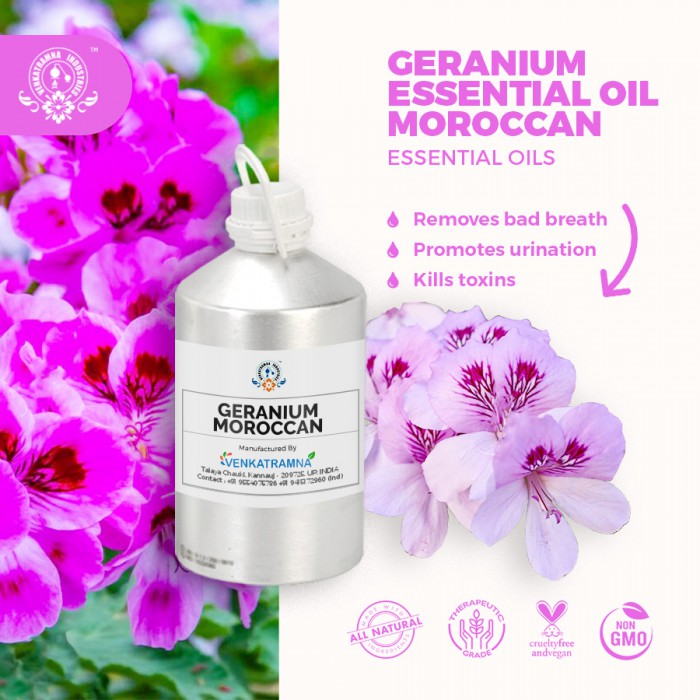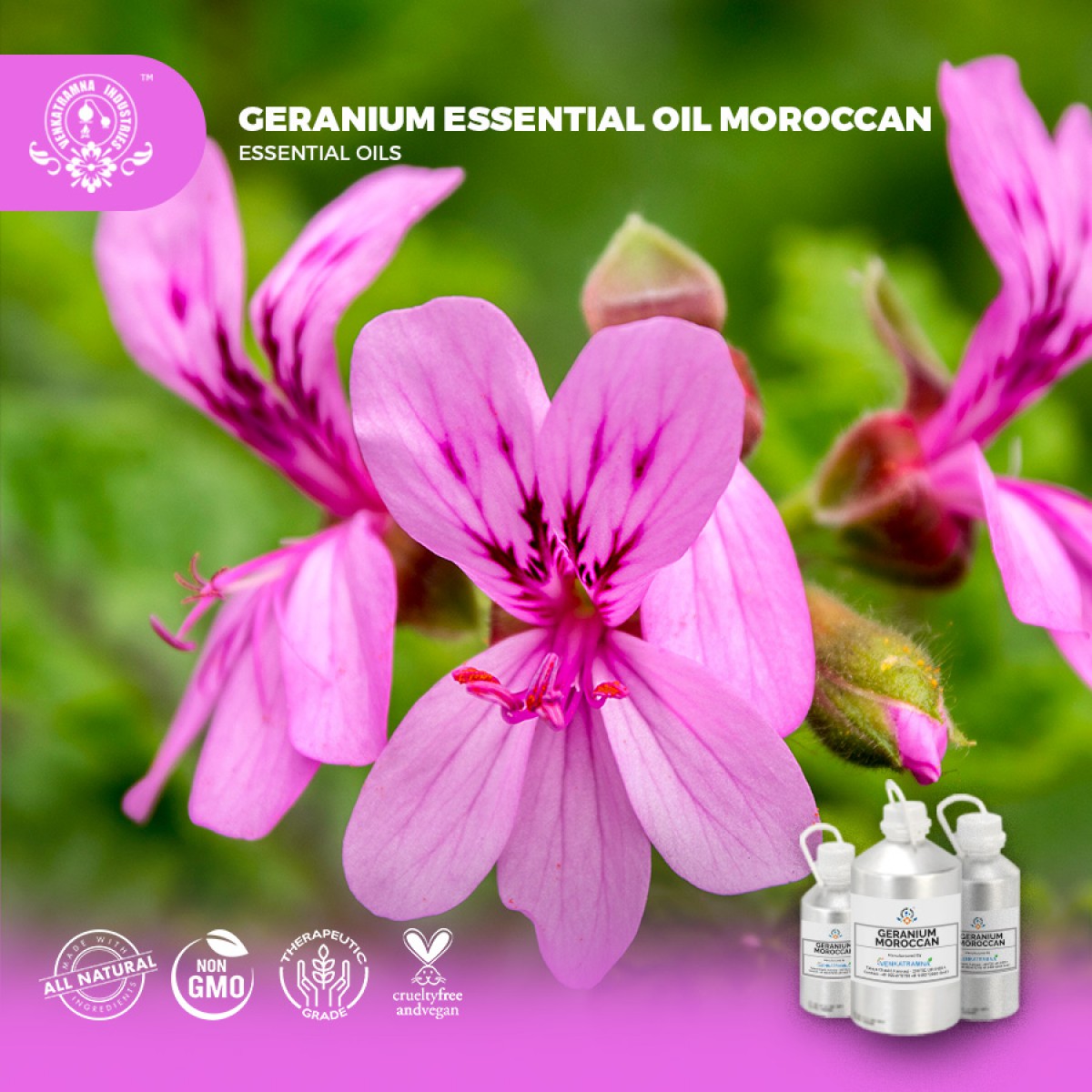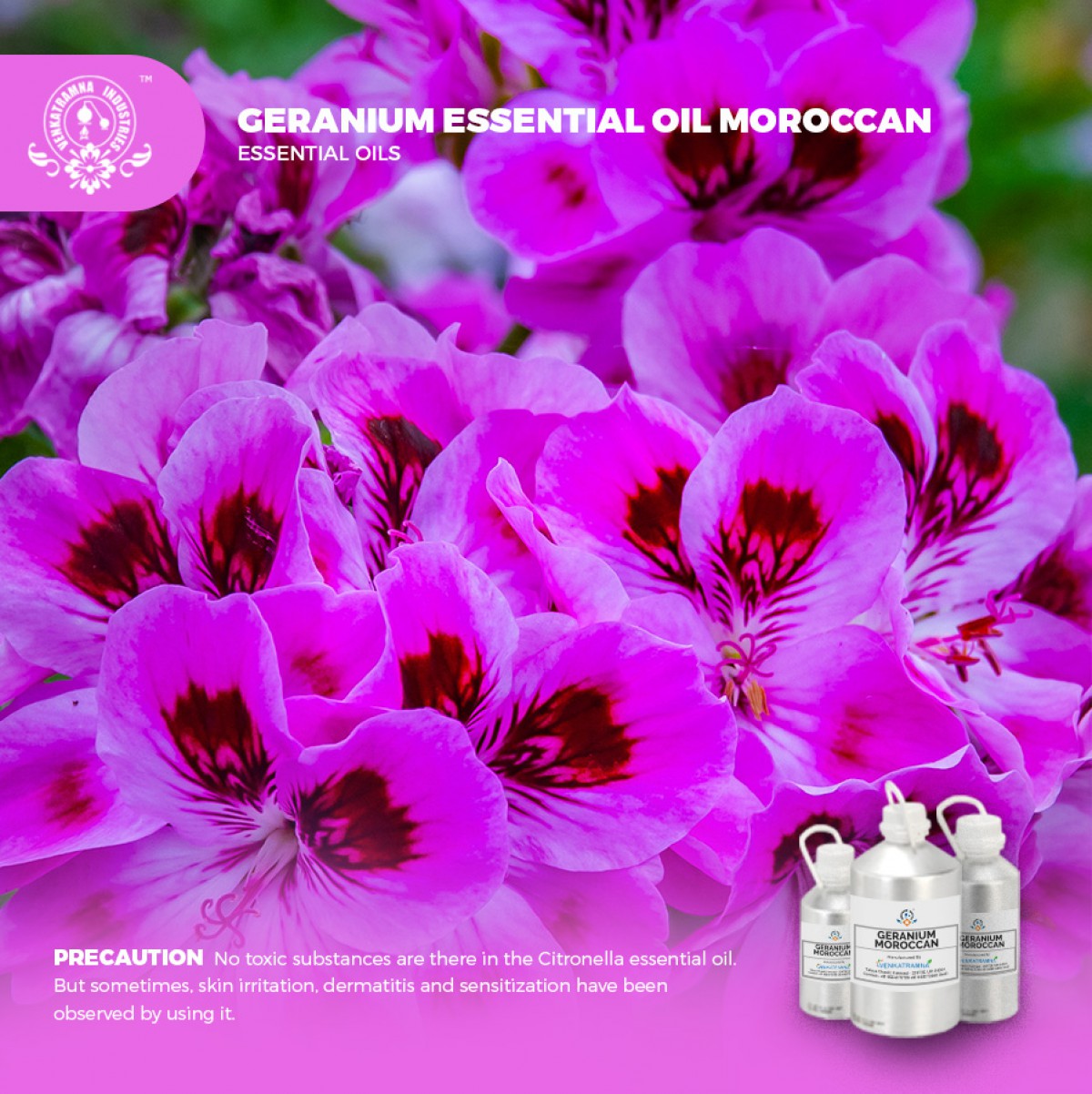Botanical Name: Pelargonium asperum (Pelargonium graveolens) Common name: Rose geraniu Read More
|
Botanical Name: |
Pelargonium asperum (Pelargonium graveolens) |
|
Common name: |
Rose geranium, sweet scented geranium, old fashion rose
geranium, rose-scent geranium |
|
Plant family: |
Geraniaceae |
|
Genus: |
Pelargonium |
|
Appearance/Color: |
A thin, pale yellow to greenish yellow liquid. |
|
Odor: |
Geranium Essential Oil smells floral, fresh, sweet and slightly
fruity. |
|
Blends With: |
Lavandin, Angelica, Carrot Seed, Bergamot, Cedar Wood,
Lemon, Jasmine, Lavender, Citronella, Grapefruit, Neroli, Lime, Basil, Orange
and Rosemary extracts. |
|
Origin: |
Morocco |
|
Source: |
Leaves, Flowers |
|
Method of
Extraction: |
Steam Distillation |
The family Geraniaceae contains
three genera: Geranium, Erodium, and Pelargonium. The names, derived from the
three Greek words meaning crane, heron, and stork, refer to the resemblance of
the seed case to the slender bills of these three birds. Pelargonium species
originate in South Africa and different species are found in distinct habitats.
The Pelargonium species related to the Geranium oil-producing cultivars are
mainly located in the Cape area.
Pelargonium plants are comprised of a myriad of hybrids and cultivars. They are bushy perennial shrubs possessing hairy, jagged leaves and clusters of small, pink striped flowers. The plant grows best in a warm temperate climate with plenty of sunshine for maximum oil development. It is sensitive to cold weather and frost averse. Glands located widely over the surface of the leaves and the green parts of the plant produce an aromatic volatile oil. Variations in the aromatic compounds of different cultivars results in diverse aromatic profiles for the different types of geranium essential oils available, that is, rose geranium, geranium or rose geranium bourbon. This is a key component of the surprise and delight inherent in plant-based aromas.
DISCLAIMER
The complete range of conditions
or methods of use are beyond our control therefore we do not assume any
responsibility and expressly disclaim any liability for any use of this
product. Information contained herein is believed to be true and accurate however,
all statements or suggestions are made without warranty, expressed or implied,
regarding accuracy of the information, the hazards connected with the use of
the material or the results to be obtained from the use thereof. Compliance
with all applicable federal, state, and local laws and local regulations
remains the responsibility of the user.
The FDA has not evaluated the
statements on this website. No claims are made by Venkatramna Industries as to
the medicinal value of any products from vriaroma.com or by us. The information
presented here is for educating our customers about the traditional uses of
essential oils and is not intended to diagnose, treat, cure, or prevent any
disease. You are responsible for understanding the safe application of these products.
If you have any questions, please call or email us for further information.
As per NAHA guidelines, New Directions Aromatics
(NDA) does not recommend the ingestion of essential oils. It is imperative to
consult a medical practitioner before using Essential Oils for therapeutic
purposes. Pregnant and nursing women and those taking prescription drugs are
especially advised not to use this product without the medical advice of a
physician. The oil should always be stored in an area that is inaccessible to
children, especially those under the age of 7.
Geranium Essential Oil rightfully
holds a beautiful reputation as an essential oil that is especially well suited
for women. It's supportive to the reproductive system, menstrual cycle and
during menopause. Its benefits, however, don't just end there. It's a wonderful
essential oil for use in balancing the skin's production of sebum and in
helping with acne. Geranium Essential Oil is astringent, and it can also be
helpful with hemorrhoids and varicose veins. Refer to the Uses selection below
for more benefits and uses. Geranium oil is widely used as an ingredient in
perfumes and cosmetics. The essential oil is also used in aromatherapy to treat
a number of health conditions.
Geranium Essential Oil in
Pharma
Geranium essential oil has been
used to treat health conditions for centuries. It is beneficial for a number of
conditions, such as anxiety, depression, infection, and pain management. It’s
thought to have antibacterial, antioxidant, and anti-inflammatory properties.
Essence of Geranium Essential Oil
The scented leaf of rose
geraniums has a history of use in the culinary arts. They are applied as
candied cake decorations or added to jams, vinegar, sugar or cakes for their
delicate floral flavour.
In aromatherapy practice geranium
essential oil finds applications in dermatological, musculoskeletal and nervous
system conditions and in supporting the female cycle.
COMMON USAGE
·
Female Reproductive Disorders
·
Menstrual Cramps
·
Infertility
·
Endometriosis
·
Premenstrual Syndrome
·
Menopausal Symptoms
·
Circulatory Disorders
·
Reynaud'S Disease
·
Varicose Veins
·
Hemorrhoids
·
Neuralgia
·
Nervous Skin Disorders
·
Depression
·
Fatigue
·
Emotional Crisis
·
Stress-related Conditions
·
Wounds
·
Acne
·
Bruises
·
Minor Burns
·
Dermatitis
·
Eczema
·
Ulcers
·
Hemorrhoids
·
Head Lice
·
Ringworm
·
Sebum Balancing
·
Urinary and Liver Tonic
Ingredients:
|
S.No |
Key Constituents |
Strength (%) |
|
1 |
Linalool |
5.6-10.0 |
|
2 |
Citronellol |
18.6-37.8 |
|
3 |
Geraniol |
15.1-20.6 |
|
4 |
Citronellyl formate |
5.5-8.1 |
|
5 |
Isomenthone |
3.8-5.6 |
|
6 |
Geranyl formate |
2.8-6.6 |
|
7 |
10-epi-g-eudesmol |
0-5.2 |
|
8 |
Geranyl tiglate |
1.1-2.4 |
|
9 |
Geranyl butyrate |
0.4-2.4 |
|
10 |
Citronellyl propionate |
0-2.5 |
|
11 |
menthone |
0.8-2.1 |
|
12 |
Geranyl propionate |
0.7-1.6 |
|
13 |
(Z)-rose oxide |
0.8-1.3 |
|
14 |
Citronellyl butyrate |
0.4-1.1 |
|
15 |
Citronellyl actetate |
0.9-1.2 |
|
16 |
Nerol |
0.6-1.2 |
|
17 |
2-phenylethyl tiglate |
0.4-1.0 |
|
18 |
a-terpineol |
0.9-1.0 |
TOXICOLOGICAL
INFORMATION
Safety Summary
·
Hazards none known.
·
Contraindications none known.
Organ-specific effects
·
Adverse skin reactions: May cause Skin irritation.
Systemic
effects
·
Acute toxicity: No information found.
·
Carcinogenic/anticarcinogenic potential: No
information found for white champaca absolute. Methyleugenol is a rodent
carcinogen when oral exposure is sufficiently high.
·
Serious eye damage/irritation: May be irritating
to eyes. Prompt rinsing and removal of the substance will avoid damage.
·
Respiratory sensitization: Breathing high
concentrations of vapor may cause anesthetic effects.
·
Germ cell mutagenicity: Not specifieds
·
Reproductive toxicity: Not specified
·
STOT-single exposure: Not specified
·
STOT-related exposure: Not specified
·
Aspiration hazard: Not specified
Dilute before use; for external
use only. May cause skin irritation in some individuals; a skin test is
recommended prior to use. Contact with eyes should be avoided.
ECOLOGICAL
INFORMATION
·
Toxicity
o
Acute fish toxicity: LC50 / 96 HOUR – No data
available
o
Toxicity to aquatic plants – No data available
o
Toxicity to microorganisms – No data available
o
Toxicity threshold – No data available
·
Persistence and Degradability: Low persistence
and high biodegradability
·
Bio-accumulative Potential: No bio-accumulative
phenomenon
·
Mobility in soil: Unknown
·
Avoid exposure to marine environments and
waterways





 MSDS-Geranium.pdf
MSDS-Geranium.pdf




